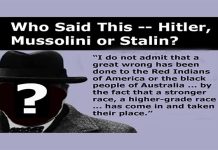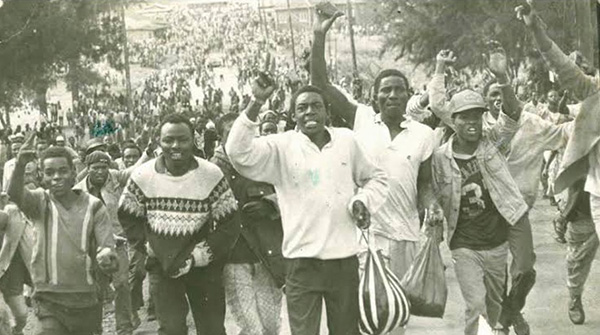
As details of state security violence and abuses by British soldiers deployed on training continue to emanate from Kenya, recently declassified files shed light on the historical impact and legacy of the British Army’s presence in the nation.
On July 7, 1990, protesters in Nairobi took to the streets to demand free elections and political pluralism in Kenya. These demonstrations, which became annually remembered as Saba Saba Day, marked significant steps toward Kenya’s eventual restoration of a multi-party political system in December 1991.
Demonstrators demanded an end to the one-party system under President Daniel arap Moi, whom British diplomats had previously described as employing a “fundamentally autocratic style” of governance. The protest received backlash from Kenya’s police force and ignited a week of rioting that spread across other districts in Kenya.
To quell the disorder, the Kenyan authorities deployed riot police, along with Kenya’s paramilitary police, the General Service Unit (GSU). The excessive and lethal force employed by these units against rioters left dozens dead and scores injured.
Recently declassified British Ministry of Defence (MOD) files have detailed that, in the years and very months preceding the bloodshed, the GSU had been in continual receipt of military training from the British Army.
Britain’s rationale in training the GSU was to maintain its use of military training facilities in Kenya that were made available to the British armed forces by the Kenyan authorities under Moi’s leadership. These training facilities were particularly important for British regiments and battalions undergoing training before deployment to Northern Ireland.
Additionally, the files reveal that Britain sought sustained use of Kenya’s civil infrastructure for military purposes and continued access to a market that was favorable to British defence exports.
To these ends, the British Government under Margaret Thatcher would willingly underwrite Moi’s dictatorship and militarily bolster his security apparatus, which would result in deadly consequences.
“Our standards”
The GSU was established as the paramilitary wing of the Kenyan police in 1948 by the British colonial government in Kenya. Initially entitled the Emergency Company, it was renamed the General Service Unit in 1953 and, at the time, consisted of 47 European officers and 1,058 Kenyans of other ranks.
One of the earliest deployments of the GSU was to suppress the Mau Mau rebellion of 1952-1960, in which the Kenya Land and Freedom Army (KLFA) unsuccessfully fought to end British colonial rule in Kenya.
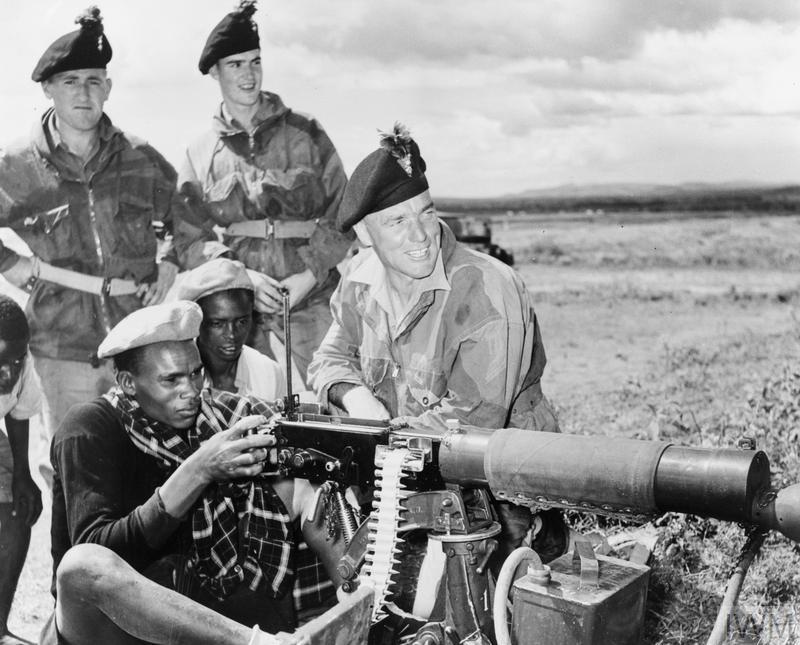
In 1989, MOD documents recorded that the GSU was “organised as infantry answerable to HQ police force,” but that its commander, Jackson Koseki, had “direct access to the President.”
A paper on defence relations with Kenya from the same year noted that British “in-country training” had “largely been restricted to the General Service Unit.” All funding for training courses for the GSU was to come from Britain’s Defence Policy Fund and was facilitated by the British Army Training Team Kenya (BATTKEN).
British training for the GSU was run by Loan Service Personnel teams and Short-Term Training Teams (STTTs), which worked with the GSU for varying durations between 1987 and 1989.
The files recorded that BATTKEN training for the GSU would continue until June 1990.

Some of the types of training on offer to the GSU would include “small arms and ammunition” courses, a “field firing package,” “platoon-level patrolling,” and “ambush skills.” Another component of training was “Riot drill,” which was noted to “not be suitable for Northern Ireland” given its “liberal use of live ammunition accompanied by bugles and banners.”
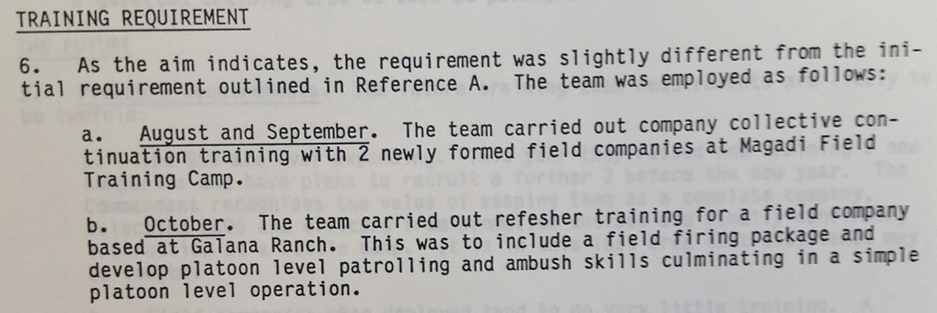
The files also documented U.S. and Israeli training of the GSU, specifically for a unit named Recce Company, which was noted to specialise in “VIP protection, hostage rescue, surveillance, and bomb disposal.”
In a letter from late June 1990 to the British Defence Attaché in Nairobi, British Army Major R Fox commented that there was “much prestige” amongst GSU recruits in having been trained by BATTKEN. He further stated that, because of the training, the GSU would now “aspire to our [British Army] standards.”
“There is no doubt that the GSU has benefitted from BATTKEN’s efforts…and we can be proud of what has been done,” he added. However, Fox also lamented the training’s shortcomings, such as a lack of military transport and poor attitudes toward training among GSU commanders.
He concluded, however, that, “in the land of the blind the one-eyed man is king, and I feel that in Kenya the GSU are the one-eyed man.”
Saba Saba Day 1990
On July 4, two former cabinet ministers in Moi’s ruling Kenya African National Union (KANU) party, Kenneth Matiba and Charles Rubia, who had become prominent opposition figures, were arrested by the security forces.
Three days later, on July 7, at Matiba and Rubia’s behest, protesters gathered at the Kamukunji grounds in Nairobi to call for a multi-party political system, free elections, and Matiba’s and Rubia’s release. The rally was deemed illegal by KANU, and police were subsequently deployed to disperse the demonstrators, sparking a week of violent rioting, which the GSU and riot police were deployed to contain.
On the third day of rioting, a report in the Kenyan newspaper Daily Nation recorded that “helmeted para-military General Service Unit (GSU) and regular policemen, wielding guns and batons, battered rioters as they dispersed them.”
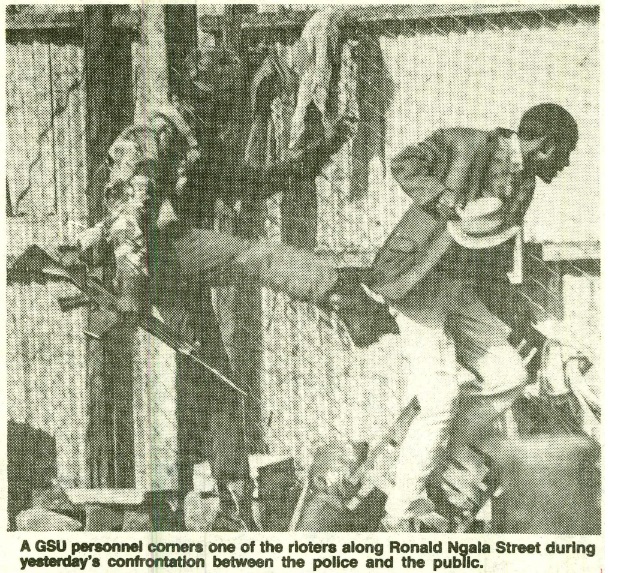
Another report, in the Kenyan newspaper The Standard, noted that “the GSU broke down several doors and set upon the occupants with sticks as children howled in fear.”
Then U.S. Ambassador to Kenya Smith Hempstone recounted that, amid the violence, “the GSU were out there with axe handles beating up grandmothers and all that sort of thing.”
Live ammunition was also used against rioters. A KANU spokesman’s statement carried by the Daily Nation admitted that, while “some of the victims were killed by rampaging mobs…others had been shot dead by security forces in self-defence.”

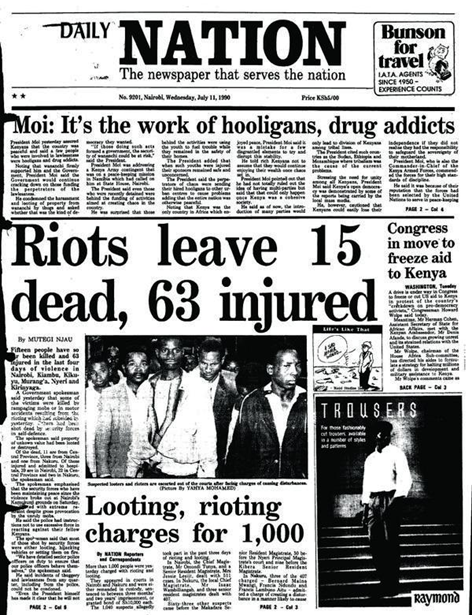
A further report noted that, in Nairobi, “sources at the Kenyatta National Hospital said at least 10 people were in serious condition at the hospital – five with gunshot wounds.”
In a medical center in the city of Nakuru, it was documented that one patient was admitted with gunshot wounds to the chest, while another “had a bullet lodged in his abdomen and was unconscious.”
A photo carried in The Standard, depicted the lifeless body of a grade 7 schoolboy who, according to the newspaper, had been shot dead by police during the violent clashes with rioters.

In the record of a meeting with President Moi on July 19, British High Commissioner in Nairobi Sir John Johnson, recorded that Moi was apparently “appalled by the shooting of young rioters” and “by the photos of dead youngsters in the press.” Moi is further noted to have said that it “had not been intended that the police should use firearms.”
By the end of the riots, it was recorded that 39 people had been killed, 69 injured, and more than 5,000 arrested.
“Good opportunities”
British Army training of the GSU was principally predicated on maintaining its use of Kenyan military training facilities, which British Minister of State for the Armed Forces Archie Hamilton described as “very valuable.”
A ministerial briefing note from the British government’s East Africa Department also noted that “UK interests in Kenya” were “substantial,” and that the training facilities the British Army did “enjoy” in Kenya were “greatly approved.”
The documents noted that Kenya offered “good opportunities for adventurous training” and provided “ideal sites for jungle, desert, and African bush type training.”
These training facilities and environments proved significant in aiding Britain’s ongoing military deployments. One British Army battalion, The Gordon Highlanders, was deployed on exercises in Kenya in early 1990, before their envisaged deployment to West Belfast in Northern Ireland in July that year. Their training in Kenya was described in the files as “undoubtedly the best training package this battalion has had in many years.”
The documents also noted the deployment of British parachute regiment 2 PARA on training in Kenya in July 1990, which would also resume operational duties in Northern Ireland in 1992.
In a meeting record penned by British diplomat David Warren in Nairobi, Moi paid tribute to the “sensitive way” in which the British Government managed its military training in Kenya.
This was noted to contrast with exercises in Kenya run by the U.S. military, which Moi said “handled the question of military training in such a way as to expose the host country to ridicule with neighbouring countries.”
British troops training in Kenya were “acceptable” because “they do things the way I want them,” Moi was recorded as stating.
In addition to the use of military training facilities, Britain also sought sustained military use of Kenyan facilities and civil infrastructure that were deemed to be of strategic importance.
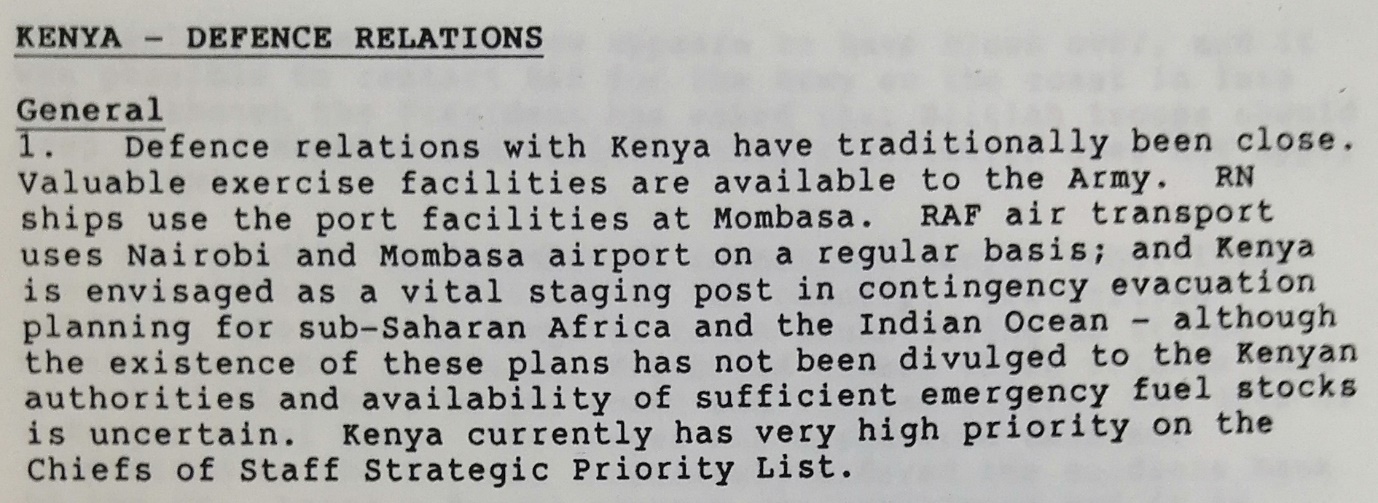
“RN [Royal Navy] ships use the port facilities at Mombasa,” the files noted. These were described as some of “the best facilities for self-maintenance periods within reach of the ARMILLA Patrol”—which was Britain’s permanent naval presence in the Persian Gulf throughout the 1980s and 1990s.
It was also recorded that “RAF [Royal Air Force] air transport uses Nairobi and Mombasa airport on a regular basis,” which were said to be useful for “training flights” and “deploying and recovering exercise troops.”
The combination of valuable training facilities and strategic military outposts available to the British Army in Kenya made the nation a “very high priority on the Chiefs of Staff Strategic Priority List,” the files noted.
“A privileged position”
Britain’s military use of civil infrastructure and training facilities were not the only components of British defence interests in Kenya that would have predicated training for the GSU.
The files also described Kenya as a “relatively good market (in African terms) for UK defence equipment.” It was further noted that “Kenyan decision-takers have traditionally looked towards the UK in satisfying a large part of their offshore procurement. This has applied to all the [armed] services.”
The Kenya Navy, in particular, was said to have served as a “very good market for UK Ltd,” and that “almost all their [Kenya’s] major vessels” were “of UK origin.”
The files continued to highlight that the Kenyan armed forces had “difficulty assimilating sophisticated equipment into service.” It was stated that, “in this respect, substantial British Army assistance in the form of Loan Service Personnel…and advisory teams has been given…to help alleviate these problems.”
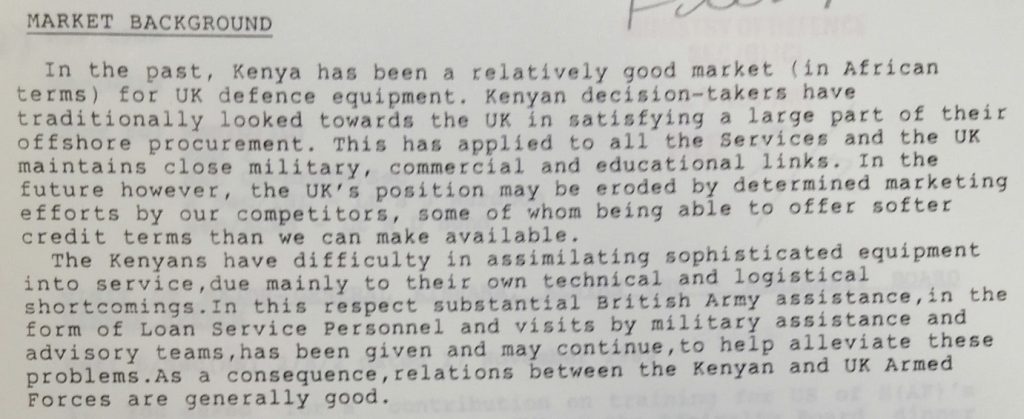
Akin to the training offered in weapon systems and military equipment, British Army training of the GSU served as a key component in upholding the UK’s advantageous defence relations with Kenya.
UK access to a favorable market for defence exports and military training facilities in Kenya constituted a defence relationship in which, according to British diplomat David Warren, Britain enjoyed a “privileged position.”
The month prior to Saba Saba Day 1990, British Foreign Secretary Douglas Hurd delivered a speech to the Overseas Development Institute. Hurd declared in his speech that “countries which tend towards pluralism, public accountability, respect for the rule of law, human rights…should be encouraged.”
“Governments which persist with repressive policies…should not expect us [Britain] to support their folly,” he added.
However, in the case of President Moi’s Kenya in the late 1980s, Britain’s support of a repressive regime not only proved permissible in advancing its strategic, military, and commercial interests but actively delivered fatal consequences.

CovertAction Magazine is made possible by subscriptions, orders and donations from readers like you.
Blow the Whistle on U.S. Imperialism
Click the whistle and donate
When you donate to CovertAction Magazine, you are supporting investigative journalism. Your contributions go directly to supporting the development, production, editing, and dissemination of the Magazine.
CovertAction Magazine does not receive corporate or government sponsorship. Yet, we hold a steadfast commitment to providing compensation for writers, editorial and technical support. Your support helps facilitate this compensation as well as increase the caliber of this work.
Please make a donation by clicking on the donate logo above and enter the amount and your credit or debit card information.
CovertAction Institute, Inc. (CAI) is a 501(c)(3) non-profit organization and your gift is tax-deductible for federal income purposes. CAI’s tax-exempt ID number is 87-2461683.
We sincerely thank you for your support.
Disclaimer: The contents of this article are the sole responsibility of the author(s). CovertAction Institute, Inc. (CAI), including its Board of Directors (BD), Editorial Board (EB), Advisory Board (AB), staff, volunteers and its projects (including CovertAction Magazine) are not responsible for any inaccurate or incorrect statement in this article. This article also does not necessarily represent the views the BD, the EB, the AB, staff, volunteers, or any members of its projects.
Differing viewpoints: CAM publishes articles with differing viewpoints in an effort to nurture vibrant debate and thoughtful critical analysis. Feel free to comment on the articles in the comment section and/or send your letters to the Editors, which we will publish in the Letters column.
Copyrighted Material: This web site may contain copyrighted material the use of which has not always been specifically authorized by the copyright owner. As a not-for-profit charitable organization incorporated in the State of New York, we are making such material available in an effort to advance the understanding of humanity’s problems and hopefully to help find solutions for those problems. We believe this constitutes a ‘fair use’ of any such copyrighted material as provided for in section 107 of the US Copyright Law. You can read more about ‘fair use’ and US Copyright Law at the Legal Information Institute of Cornell Law School.
Republishing: CovertAction Magazine (CAM) grants permission to cross-post CAM articles on not-for-profit community internet sites as long as the source is acknowledged together with a hyperlink to the original CovertAction Magazine article. Also, kindly let us know at info@CovertActionMagazine.com. For publication of CAM articles in print or other forms including commercial internet sites, contact: info@CovertActionMagazine.com.
By using this site, you agree to these terms above.
About the Author

Patrick O’Reilly is an independent journalist and researcher.
Focusing on Western foreign policy and UK healthcare governance, he has previously written for Declassified UK, antiwar.com and The Bristol Cable.
Patrick can be reached at pd.oreilly10@gmail.com.

